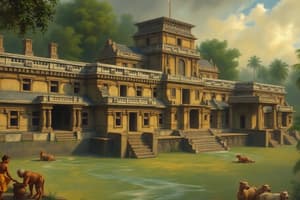Podcast
Questions and Answers
Why didn't Mesoamerican and Andean civilizations have contact with one another?
Why didn't Mesoamerican and Andean civilizations have contact with one another?
Rugged mountainous terrain, everything was cut by mountains and valleys, microclimates created economic and biological diversity.
What did the diverse peoples of Mesoamerica share in terms of culture, despite their differences?
What did the diverse peoples of Mesoamerica share in terms of culture, despite their differences?
Intensive agricultural technologies, market exchange economy, similar religious practices, common ritual calendar, hieroglyphic writing.
What were the dates for and the achievements of the Maya civilization?
What were the dates for and the achievements of the Maya civilization?
250-900 C.E.; urban centers, elaborate writing system, mathematical system including the concept of zero.
How was the Maya civilization organized politically?
How was the Maya civilization organized politically?
How did the Aztec Empire come to be?
How did the Aztec Empire come to be?
Describe the city of Tenochtitlan.
Describe the city of Tenochtitlan.
Explain the connection between slavery and the religious order of the Aztec civilization.
Explain the connection between slavery and the religious order of the Aztec civilization.
Compare the Inca and Aztec empires.
Compare the Inca and Aztec empires.
Describe the Inca government and bureaucracy.
Describe the Inca government and bureaucracy.
What was the mita and how does it compare to the Aztec empire?
What was the mita and how does it compare to the Aztec empire?
What was gender parallelism?
What was gender parallelism?
What problems do historians have with the term 'world civilization'?
What problems do historians have with the term 'world civilization'?
What are the contributions of pre-modern civilizations?
What are the contributions of pre-modern civilizations?
Flashcards are hidden until you start studying
Study Notes
Mesoamerican and Andean Civilizations Overview
- Mesoamerican and Andean civilizations were geographically isolated due to rugged mountainous terrain, which divided areas with mountains and valleys, fostering unique microclimates.
Cultural Exchange in Mesoamerica
- Diverse cultures shared intensive agricultural practices focused on crops such as maize, beans, chili peppers, and squash.
- Economies were based on market exchanges, highlighting trade between different groups.
- Religious practices included a pantheon of male and female deities, rites centered around a cosmological understanding of creation and destruction, human sacrifices, and monumental ceremonial centers.
- Common elements included a ritual calendar and a system of hieroglyphic writing.
Maya Civilization
- Existed from 250-900 C.E.; noted for its urban centers featuring temples, pyramids, and plazas.
- Developed a sophisticated writing system combining phonetic and syllabic elements and a mathematical system that introduced the concept of zero and set notation.
Political Organization of the Maya
- The Maya had a fragmented political structure comprising city-states and regional kingdoms, characterized by local lords and ongoing warfare without a central authority.
Rise of the Aztec Empire
- Originated from the semi-nomadic Mexica, who migrated south and settled on an island in Lake Texcoco, leading to the establishment of the Aztec Empire.
Tenochtitlan
- Capital city with a population between 150,000 and 200,000, featuring an intricate system of canals, dikes, causeways, and bridges.
- Central area contained palaces and temples, surrounded by chinampas (floating gardens) that enabled increased agricultural productivity.
Aztec Religion and Slavery
- Warfare captives became slaves used in vital rituals, as the Aztecs believed that blood sacrifices were necessary to sustain gods, particularly the sun god, in their battle against darkness.
- This ideology underpinned the justifications for warfare, aiming to maintain cosmic order.
Inca and Aztec Comparison
- In-depth comparison available through supplementary materials; highlights differences and similarities between the two empires.
Inca Government Structure
- Governed by a divine emperor overseeing 80 provinces, each managed by an Incan governor.
- The state owned all land and resources, with local officers coordinated by an Incan administrator in central regions.
Mita System in Inca Society
- Mita was a labor system demanding periodic service from households for state agriculture, military, or construction projects.
- Comparable to the labor expectations of conquered peoples in the Aztec Empire, who provided resources for elite projects.
Gender Parallelism in Andean Societies
- Concept where men and women operated in distinct, autonomous spheres, reflecting gender roles within society.
Historiographical Challenges
- The term "civilization" implies superiority, leading to issues regarding how various cultures are classified and perceived.
- Simplistic categorizations may not accurately reflect shared identities or territorial borders.
Contributions of Pre-Modern Civilizations
- Negative aspects included frequent warfare and religious tensions among differing faiths.
- Positive contributions consisted of advancements in agriculture and warfare technologies, growth in arts and literature, and fluctuating gender roles contributing to societal dynamics.
Studying That Suits You
Use AI to generate personalized quizzes and flashcards to suit your learning preferences.




